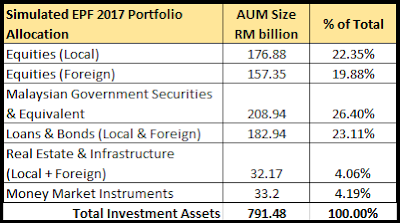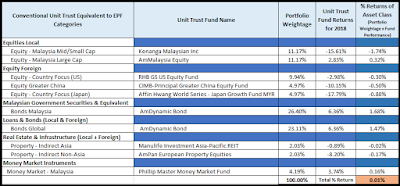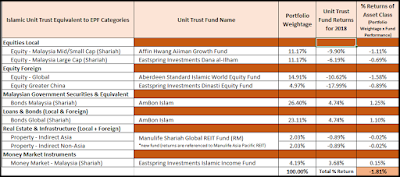EPF Investment Portfolio vs Unit Trust Portfolio, which one is better?
Shane My
Publish date: Sat, 17 Aug 2019, 09:31 AM
 |
| EPF 2017 Asset Allocation and Gross Income |
Step 1: Generate EPF's Local and Foreign Portfolio Allocation
 |
| Simulated EPF Portfolio for 2017 |
The table below show matches the simulated EPF portfolio to Unit Trust Categories under Conventional and Shariah:
 |
| Matching EPF Portfolio to Unit Trust Categories |
The Unit Trust Portfolio for Conventional and Islamic are constructed based on the fund returns in 2017 as shown in the tables below:
 |
| Conventional Unit Trust Portfolio equivalent of EPF for 2017 |
 |
| Islamic Unit Trust Portfolio equivalent of EPF for 2017 |
Step 4: How does the same unit trust portfolio fare in 2018?
As mentioned earlier in this blog post, 2018 was a year of losses for equities which significantly impacted the performance of both unit trust portfolios as shown below:
 |
| Conventional Unit Trust Portfolio equivalent of EPF for 2018 |
 |
| Islamic Unit Trust Portfolio equivalent of EPF for 2018 |
Summary
I have also summarized in the table below the compounded returns over 2 years (2017 and 2018) for both the Unit Trust Portfolios versus EPF dividend return.
Despite selecting the top performing unit trust funds to be included into the constructed portfolio, EPF cumulative returns still outperformed the cumulative returns of both Unit Trust portfolios over a period of two years. The consistency of EPF in producing positive return is unparalleled and jives with many Malaysians whom prefer consistent and stable returns for our live savings.
Never the less, unit trust will always be an option for investors with higher risk appetite. An experienced and knowledgeable investor would be able to apply the right strategy in order to take advantage of the various opportunities that arise from market and fund volatility. Huge double digit returns for an investor is totally possible as illustrated in the returns for the 2017 portfolio.
I hope this article has been an enlightening one in terms of helping investors to understand both EPF as well as Unit Trust. If you like this post, please feel free to share this and do follow me at Invest Made Easy Facebook for future updates!
Cheers and Happy Investing!
Join the discussion EPF versus UT Portfolio HERE
More articles on Invest Made Easy
Created by Shane My | Dec 06, 2020
Discussions
A few comments here,
1) Short-term return of Unit trust funds, and its comparison has not much meaning as upfront fee will trash the real return.
2) Investment in unit trust funds, or any investment for that matter, has to be long-term, and comparison has to be long-term in term of compounded annual return, CAR.
3) Compounded return is normally in annual basis, or more precisely, compounded annual rate of return.
4) Cumulative return, say over two years, is not the same as CAR.
5) Return alone says little about how good the strategy is. It has to consider in parallel with the risk involved.
6) The risk profiles of unit trust investment and EPF dividend are totally different.
7) Unit trust investment may be good for those who have no knowledge about investing in stocks, but asking EPF contributor to withdraw their money to invest in unit trust, in my personal opinion, is highly irresponsible.
8) Why 7 above? Go check the return of unit trust funds over 3 years, 5-year, 10-years or longer periods in Malaysia, and compare with the return of EPF. I haven't taken into consideration of risk-adjusted return yet.
2019-08-18 09:36
So, just leave money in EPF, is much safer option, with good comparative returns.
2019-08-18 09:48
Safety of capital is almost guarantee, dont expect hugh annual returns like 20%, etc , but anytime better option for retiree age contributors
2019-08-18 09:50
Epf trumps unit trust price any time. the sales charge le y by unit trust company (5%) is a killer not to mention the management fee etc
2019-08-19 08:15




















calvintaneng
YOU MUST BUY A STOCK WITH GOOD FUNDAMENTAL FOR SAFETY
EXAMPLE IS UZMA AT 66.5 SEN WITH NTA OF RM1.54 (MORE THAN 50% DISCOUNT TO NTA WHICH GIVES MARGIN OF SAFETY
THEN YOU MUST KNOW A STOCK CAN MOVE IF THERE IS COMING CATALYST
WHAT CATALYST UZMA GOT?
ANSWER
UZMA GOT 12 MONTHS CONTRACT JOBS (PLUS MANY OTHER JOBS AWARDED) TO DISMANTLE & DECOMMISSION 22 OIL RIGS
BECAUSE OF MONSOON FROM NOVEMBER TO MARCH 2019 (5 MONTHS OF MONSOON IN SOUTH CHINA SEA) ONLY 6 OIL RIGS WERE DISMANTLED
SO AFTER APRIL 2019 MONSOON OVER UZMA WILL CONTINUE TO DISMANTLE 16 MORE OIL RIGS
THESE GOOD MONTHS OF APRIL TO JUNE 2019 SHOULD REPORT BETTER PROFITS FOR UZMA
SO HIGH PROFITS WILL BE A CATALYST AS PEOPLE WANT "EARNINGS"
AND ANOTHER PONTER IS UZMA DIRECTORS ARE TURNING BULLISH AND BUYING UZMA SHARES WITH THEIR OWN POCKET MONIES
SO ALL FACTORS POINT TO UZMA AS A GREAT BUY NOW!!!
2019-08-17 16:32